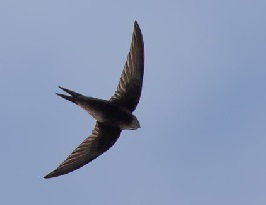 | > Other English exercises on the same topics: Animals | Making portraits, describing | Nature [Change theme] |
| > Similar tests: - Describing a face - Animals (video) - Animals - Describing a picture - In the sea - Animals & insects - Animals and pictures - Animals | |
| > Double-click on words you don't understand |
Black swift 2 - English lesson
In test, I told you about swifts nesting in the putlog holes of our buildings when those over three-year-old breed, because otherwise they never land! Black swifts arrive every year in Europe, during April after crossing Africa, where they spend the winter months.
Once the nest is found and the couple is reformed, (because they do not arrive at the same time and do not follow the same paths), the incubation lasts about seventeen to twenty-two days. The female lays two to three eggs, a few days apart, depending on the meteorology (the time between the first and third eggs can reach the week)! It is only when the third egg is laid that the parents incubate in turn for about three weeks.
At the end of April to mid-May, it's the birth boom. The chicks are bald, deaf, blind, but they take away their insect rations with a ferocious appetite from their parents. Our roofs become the scene of incessant comings and goings to feed their hungry offspring, whose cries are piercing. It's really fascinating to watch them decelerate just before reaching their nest in the tiny opening!
Sometimes, when the sun is too hot, the chicks try to escape from the nest furnace when they are not yet fully feathered. On the ground, they are always in danger of death (hunger, organ injuries, or predation)! Adults have great difficulties taking off from the ground because they are too short-legged birds, and therefore they will not come to feed them, unlike other birds that would experience such misadventure.
If an adult is on the ground, it is because it is exhausted, injured or thirsty. Give it one to two drops of clear water at the end of a clean cotton swab that the swift will suck to drink, placing the cotton swab along the beak, without forcing on the beak.
(!)(!)(!) Be careful, it could drown, its nostrils are at the begining of and above its tiny beak.
The bird will have to be put in a blunt cardboard box large enough to spread its wings, so as not to be injured and let it breathe, the bottom lined with paper towels, which will prevent it from soiling its feathers to be able to fly as soon as possible.
If you find a nestling, the mission is more delicate ! Do as if it were an adult, and then call for a wildlife centre, after weighing the bird to the nearest gram, and describes as accurately as possible the condition of their feathers, which helps to determine its age, its needs, and its chances of survival. It needs forty days to complete all its feathers to be they are at the right length to allow it all its aerial acrobatics.
(!)(!)(!)Never give it any cat food, minced meat, milk, or bread. Birds never tolerate bread that destroys their organs, and their feathers and finally condemns them to death, this is true unfortunately for all birds!
Swifts are strictly insectivorous. Their part of insects must be prepared and given to the swifts every two hours... (neither wings, nor legs, and neither chitin nor antenna). For birds that almost never land, the condition and excellent health of the feathers is paramount. It's hard to make them eat, because they don't open their beaks easily... and you can break it, by manipulating them inappropriately! Plus, they move a lot, and struggle! Small, but very energetic!
If you encounter swifts on the ground, please call for specialists, such as local Wildlife Protection Associations.
At the end of July, young nestlings which are able to fly (they only weigh forty grams), begin their first trip, with adults. The others will leave later... if they can!
Data on swifts are recent because this species arises only to nest. Enthusiasts take turns to help, study, feed and care for these remarkable and courageous birds.
In a future test, we will discuss policies here and there, for the reception and protection of the swifts.
Choose the right answers. All of them are given in this text.
Now, you can try.
Have fun and good luck to you!

English exercise "Black swift 2" created by chocolatcitron with The test builder. [More lessons & exercises from chocolatcitron]
Click here to see the current stats of this English test
End of the free exercise to learn English: Black swift 2
A free English exercise to learn English.
Other English exercises on the same topics : Animals | Making portraits, describing | Nature | All our lessons and exercises


